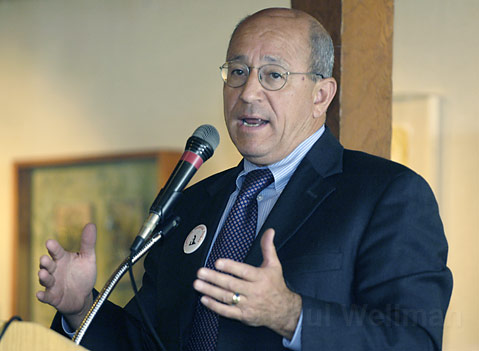Nava’s Office Cuts Red Tape
Constituent's Unemployment Was Exacerbated by Bureaucratic Frustration

The unemployed have a serious job ahead of them in getting unemployment insurance.
Kelly Kish, a local architect and construction project manager, lost his job on May 4, applied for unemployment insurance the next day, and has been battling the phone system and bureaucracy at the Employment Development Department (EDD) for months since.
In the meantime, Kish’s phone has been disconnected, his car has been repossessed, he’s had to go on welfare and use food stamps, and his landlord has threatened eviction, leaving this Berkeley graduate with a master’s degree from UCLA to suffer from what he calls “absolute desperation.”
In a complicated series of submitted applications, lost applications, filed claims, and phone calls (which Kish says have cost him more than $100 in the last month just trying to get through to representatives), Kish has experienced the EDD in ways that many other unemployed individuals have. “The most frustrating thing is not getting through,” he said, explaining how much of the time he can’t even get in touch with a human being on the other end of the line. To make matters worse, he says he’s been hung up on twice by the very representatives that are so hard to get in touch with, some of whom don’t even have access to his records, making any sort of headway while on the phone nearly impossible.
Ultimately, according to Kish, the thing that turned the tide of his frustration was calling Assemblymember Pedro Nava’s office in a desperate attempt to get help in dealing with the unwieldy EDD system. “They were very helpful,” said Kish, who explained that after leaving a message he was promptly called back. “They’ve heard numerous stories like this,” he said. After having called the EDD multiple times a day for weeks without much success, Kish got an email from the EDD two days after contacting Nava’s office-a small but important victory.
The people on the other side of the phone lines haven’t had a much easier job. Isaac Richardson, an associate government program analyst with the EDD, is just one of the people who has dealt with Kish’s case. Asked about the trouble that Kish had with the EDD, Richardson pointed out that people with complaints of that sort “only give one side of the story.” Richardson cited errors in forms as a common cause of drawn-out application processes-perhaps mistakes similar to failing to fill in a date, as Kish did when he first submitted his application.
But returned applications aren’t the only or even the most common complaint among those applying for unemployment insurance. The phone system is the greatest point of frustration for many, who find themselves spending whole days calling the EDD time and time again and never getting through to more than a seemingly infinite series of voice prompts. Kish’s guess that the system was “overwhelmed” proves to be something of an understatement. Richardson explained that of every 70,000 to 75,000 calls placed to the EDD every day, only 20,000 or 22,000 can be accommodated and answered. Recently, due to the economy, extra unemployment insurance extensions were approved for everyone who had received payments in the last two or three years, resulting in an enormous flood of calls. These extensions, which started in July made it “two to three times harder” to get through, according to Richardson, who mentioned that the EDD has had to hire 800 more people to answer phones in the last few months in an attempt to ameliorate the problem.
“We have to work extra time,” says Richardson, who said that the EDD is “always working on improving the system.” But when asked whether something can be done to improve the rate of only one in four or five calls being answered, he said that the system is functioning “at the max” and that there are limitations outside of the EDD’s control. Furthermore, “25 percent doesn’t give a true picture,” he said, pointing out that this statistic doesn’t mean only a quarter of the callers are accommodated. Most callers just “hang up and call right back” for hours, despite a prompt asking them to call back at a later time when there is less phone traffic.
A member of Pedro Nava’s staff explained that while the assemblymember’s office does have contacts at EDD and other state organizations that help to expedite the turnaround of information and circumvent the phone system, a lot of the frustrated people who call his office don’t actually understand the process that their applications are going through.
On Thursday, August 20, 108 days after his first application was filed, Kelly Kish says that as far as he can tell, “The constipation has been cleared.” He received a check in the mail covering many of the missed payments from the period during which his application was buried in the bureaucratic shuffle. Though Kish’s case took almost 10 times what Richardson said is the average processing time, a 10-day turnaround is admirable when one considers the number of people processed by this convoluted but crucial support system for the unemployed.



